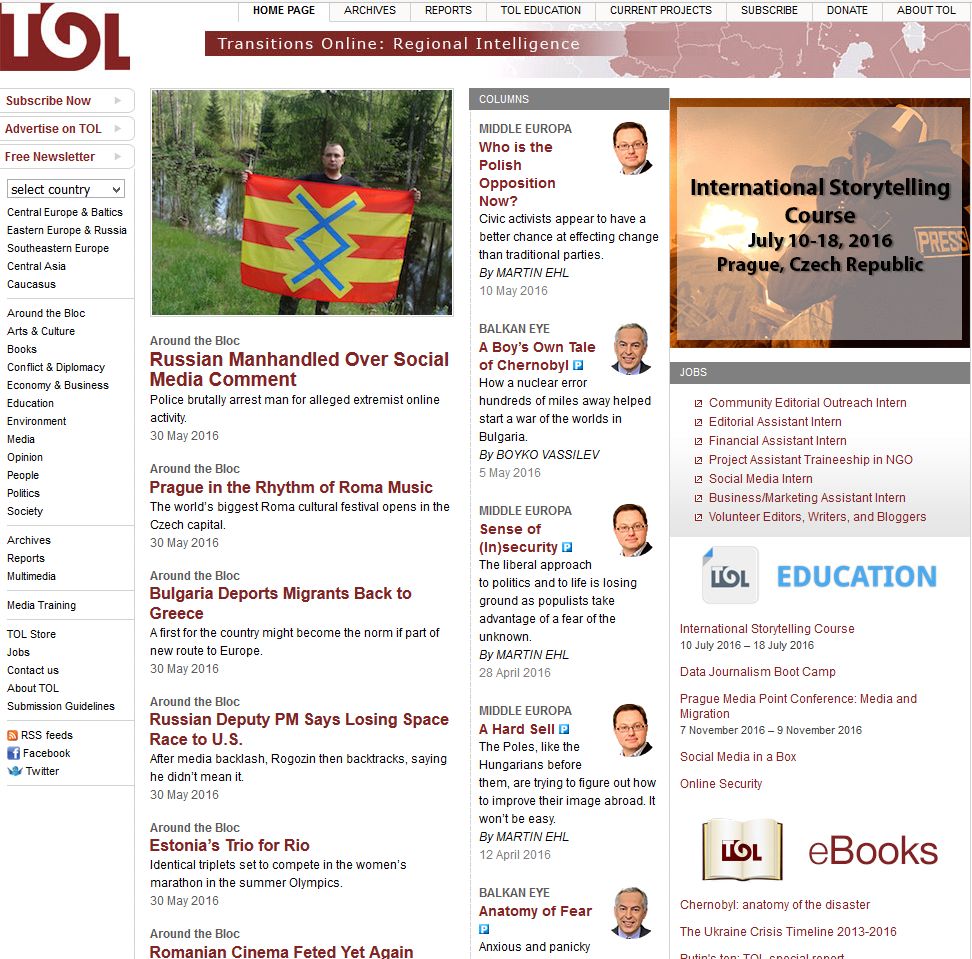
Around the Bloc: Russia’s Supreme Court to Hear Ukrainian Filmmaker’s Appeal
Lawyer for Crimea native Oleg Sentsov, jailed for 20 years on terrorism charges, hopes for reduced sentence.
More...We kindly inform you that, as long as the subject affiliation of our 300.000+ articles is in progress, you might get unsufficient or no results on your third level or second level search. In this case, please broaden your search criteria.

Lawyer for Crimea native Oleg Sentsov, jailed for 20 years on terrorism charges, hopes for reduced sentence.
More...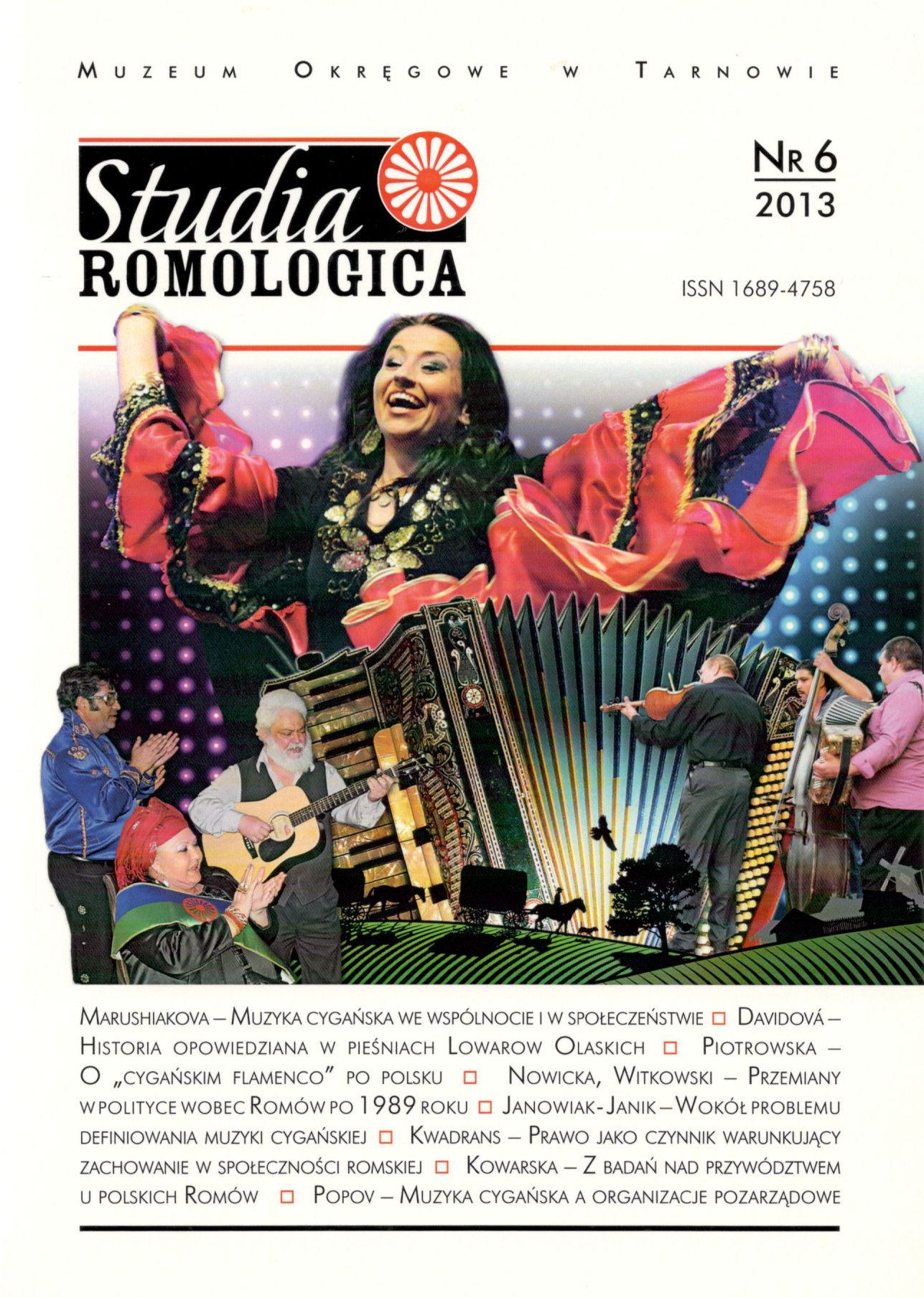
The Gypsies (Roma and other Gypsy communities) are actually an example how a people can exist in two dimensions – as a separate community/communities and as a more or less separated part of the society. Numerous researches of Romani studies scholar till now paid attention mostly on them as detached, specific community, but when speaking about ethnomusicology a paradox is observed. Main subject of majority researches are the Gypsy musicians, who serve the surrounding society, i.e. Roma are studied not so much as community, but rather as part of the society. The present article analyses the different spheres of functioning of the Gypsy music in the society and within the society and their mutual overlapping. Special attention is paid on role of the music within the Gypsy communities – in the different family (mainly during weddings) and calendar holidays, during the different rituals, in the everyday life, in different midst (family, age and/or sex restricted). On this ba¬sis the different appearances of the community identity of the Gypsies are analyzed, as well as the role, which the “Gypsy Music” (determined as such by the community itself) has on its creation and expression.
More...
The article is an overview of the Olah Romas‘ song folklore and lyrics in the former Czechoslovakia – in Bohemia, Moravia and Slovakia, where until today it has retained its active existence in an unchanged form – in particular among the group Lovari. While the music and folk songs of the Roma are relatively known, the Olah folklore in its authentic form remains rather unknown. It has been transmitted through generations in an uninfluenced form even after these societies were forced to stop being migratory by the power of the communist state in 1959. Their song folklore is differentiated in structure, forms, types and way of performance, and divided into two main groups of songs: Mulatousha, louke djila which are long, slow songs, and Khelimaske djila which are rhythmical songs to be danced to. This article examines the lyrics and content of these songs and also focuses on their specific function in the Olah society. The majority of these songs are traditionally without a musical accompaniment which increases the importance of their lyrics. The singer tells through them a story to the community to whom he dedicates the song by the way of a ritual formula – which adds to the atmosphere of the song as far as both content and rhythm are concerned. The author of the article chose ex¬amples of the lyrics from her large collection of original recordings made between the years 1956 and 1990. The texts are transcribed from the recordings in the Olah Roma language and then loosely translated.
More...
The article outlines Polish literature dedicated to the phenomenon of flamenco. An author not only presents the state of research on flamenco in Poland, but also refers readers both to the earliest and to the most popular works on flamenco functioning abroad. While analyzing Polish literature Piotrowska asks a question about general attitude of Polish authors towards the issue of ‘Gypsyness’ of flamenco and presents how Polish writers treat Gypsy roots of flamenco. The author concludes that in Polish literature – comprising a few articles and books – Gypsy connotations of fla¬menco are usually duly underlined. At the same time, Piotrowska states that Polish literature on flamenco is dominated by practical approach focusing on performantive practices (dance, instrumental play), rather than on historic or aesthetic perspective. The author stresses the absence of Polish translations of important books on flamen¬co, however she also acknowledges the role Polish Internet sites play in promoting the Gypsy aspect of flamenco phenomenon.
More...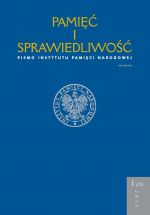
The purpose of this text is to attempt a synthetic portrayal of the issue of memory of the Second World War as a source of inspiration in Polish contemporary art since 1989. The year 1989, which marked the beginning of systemic transformation in Poland, was also the beginning of the process of transformation of the paradigm of collective memory of World War II. The appearance of issues omitted in the institutionalized discourse of the period of the Polish People’ s Republic contributed to an increase in artists’ interest in the mechanisms of constructing the collective image of the past. The particular ‘memory boom,’ which involved a sharp increase in the number of publications on so-called ‘white spots’ in the history of Poland, also manifested itself in the visual arts, among others, in the works of Mirosław Bałka, Zbigniew Libera, Wilhelm Sasnal, Piotr Uklański and Artur Żmijewski. Most of the works created in the 1990s and in the first decade of the 21st century concerned the memory of the Holocaust and Polish-Jewish relations during the German occupation. In many cases, the means of artistic expression employed by their creators evoked controversy and objections by those who found them inappropriate. The basic objections raised against artists referring to ‘war issues’ were: the instrumental references to the issue of the Holocaust, dictated by trends, and the lack of deep reflection on the attitudes ofperpetrators, victims and witnesses of the events at that time. The fact that artists drew from collective images brought with it other effects also. Many works created in this period served the following functions: c a t h a r t i c – involving the purification through art of the recipient’ s feelings and emotions, h e u r i s t i c – resulting from treating creation and its outcomes as a research process whose important elements include the posing of hypotheses and their verification, m n e m o t e c h n i c a l – being an exercise in memory through the medium of art and, finally – c o m m e m o r at i v e, embedded – following Pierre Nora – in the era of commemoration and the call to remembrance. The manners of portraying themes of memory of the war in Polish contemporary art since 1989 seem to have confirmed the social aspect of artistic creation, involving – in the case being discussed – the exposing of, but also the formation of collective images of the past.
More...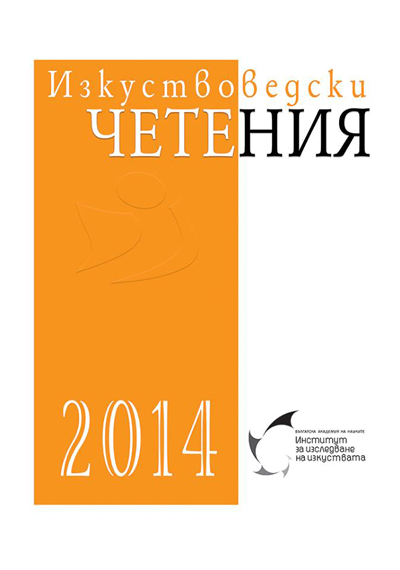
Christo [Vladimirov Javacheff] and Jeanne-Claude [Marie Denat] came to Australia in 1968 and with their site-specific installation had a profound impact on the development of conceptual art in Australia. Christo was born in Gabrovo in 1935 and was a graduate of the Fine Arts Academy in Sofia. His partner in art and life, the Frenchborn artist, Jeanne-Claude (1935-2009), met Christo in Paris in 1958 and together they became two of the most influential artists involved in conceptual art on the world stage. A peculiarity of their work was the ‘wrapping’ of objects leading to a transformation in their physical and conceptual existence. Their project in Australia was immense in scale, raised many significant conceptual questions and involved a large number of Australian collaborators for whom this was a defining moment in their development as artists. Christo and Jeanne-Claude’s project was titled Wrapped Coast, One Million Square Feet, Little Bay, Sydney, Australia and was held over two months in 1968-69. It involved the spread of 1,000,000 square feet (92,900 square meters) of erosion control fabric with 35 miles (56.3 kilometres) of rope, with a total length of 2.4 kilometres and a height of 26 meters which completely transformed a scenic stretch of the Australian coastline. This was a controversial event which divided the Australian art community and in retrospect has been viewed as a transformational moment in the development of Australian art. This paper examines the significance of the event from the perspective of almost fifty years.
More...
The packaging manufacturing industry is rapidly evolving and energetically developing. The barometer pointer for the promotion of a particular product depends almost entirely on the packaging. The article traces out the world trends in the packaging sector, presenting emblematic brands that have developed the fundamentals of packaging design. The earliest significant packages of the past as well as contemporary trends are analysed. The focus is on leading brands, which are trailblazers in the sector such as Coca-Cola, Walt Disney, LEGO, McDonald’s, Nestlé, Royal Dutch Shell, P&G. Children’s packages inspired by actual fashion trends not necessarily consistent with the age group of the consumer body are under consideration. The packaging design of children’s products is the essence of public taste and culture, reflecting fashion nowadays.
More...
The article is part of a study on Bulgarian theatre under socialism. It focuses on the repertory policy after the political changes from 1944 onwards. The new authorities gradually and systematically got control over all of them. The main priority was to rehabilitate the people and arts were believed to be the possible tools to achieve this goal. In this way, the authorities linked culture, arts and theatre with propaganda. A party-political regulation over culture, and respectively, over theatre, was enforced in all areas, from repertories to personal cases. Total control was exerted universally, but especially over the texts and the repertories, which were treated with increasing attention.
More...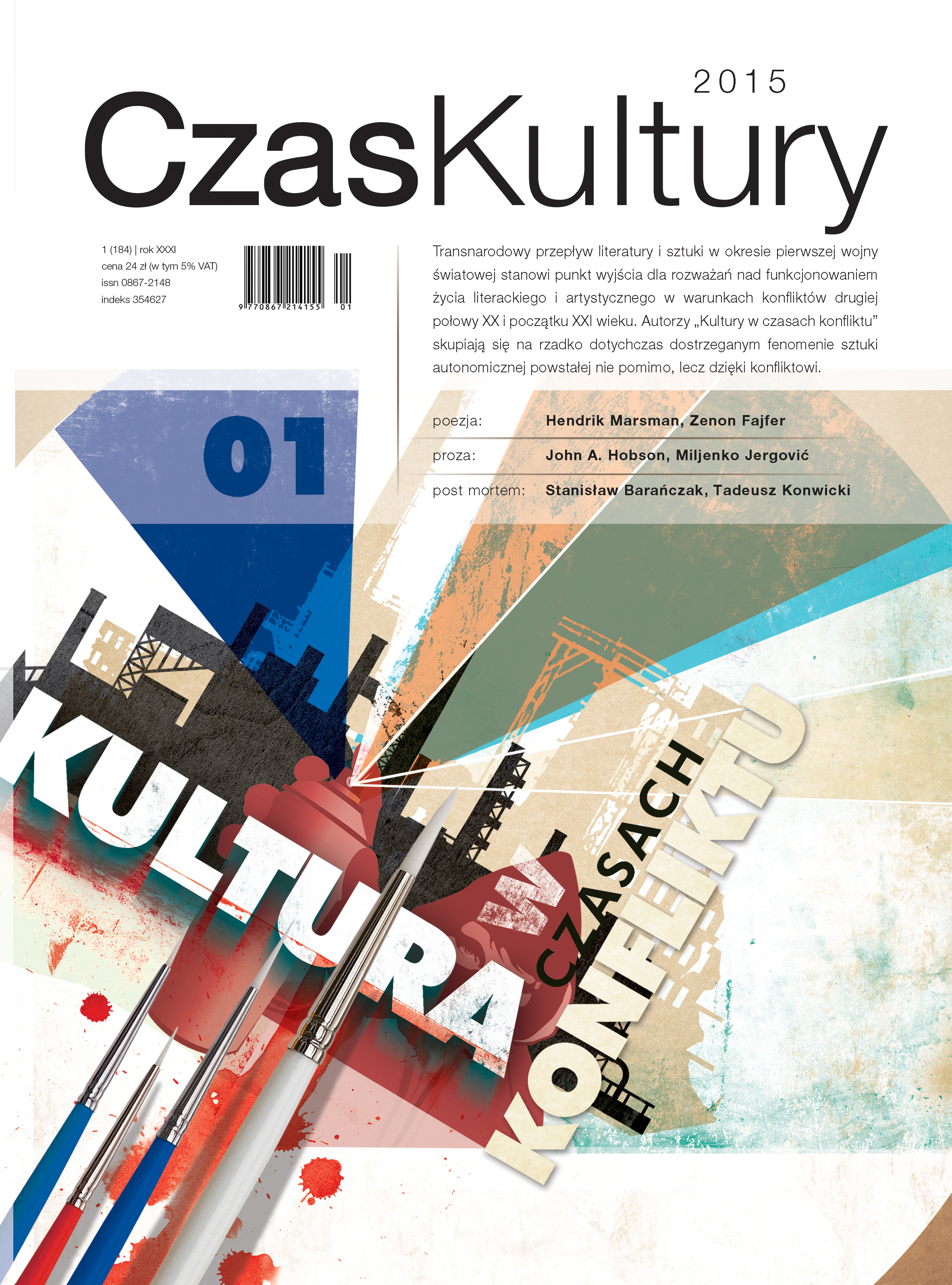
Artistic responses to the Maidan can be seen as a new form of socially and politically engaged art, whose methods and language are adapted to today’s times. Artists used the internet, in particular, to launch several projects in support of the Maidan. The Facebook page “Strike-Poster” functioned as a database of anti-government political art (prints and posters) to be used by the protesters. A new form of social media was launched – “hromadske.tv”, an internet television channel that functioned as a source of uncensored news, including cultural news. Among other projects was the creation of an artistic enclave (Artistic Barbican) on the Maidan, where exhibitions of often non-professional political art were held. A number of individuals carried out a series of performances in the square with a clear political message, and various participatory projects were organized, such as Maidan Post, with postcards designed and printed by artists themselves. Well-known artists of the younger generation joined the demonstrations and either documented them (e.g. photos of barricades by Alevtina Kahidze) or produced portraits of the revolutionaries, including those who died (Lesia Khomenko, Serhij Radkievich). Recent developments in Kyiv have clearly shown once again that in a divided society, such as post-communist Ukraine, the gaps between social groups can be closed by turning to basic principles, such as personal freedom, dignity and civil liberties, as well as national myths. In order to succeed, these revolutionary impulses need to come from within society. In this process, art and artists play a crucial role in building a common platform for communication. The events in Ukraine led to a re-evaluation of the importance of art functioning outside of institutions and the art market, and which is capable of speaking about issues of crucial importance to today’s world and the fundamental values upon which civil society is based.
More...
The article presents a silhouette of Konwicki not only in the context of his achievements in Polish prose and film, but also through the roles he assumed at different stages in his career: as a writer supporting the new post-war political system, as a film author seen through a portrait created by critics and future filmmakers of the new French New Wave, and as a commentator on his own work, which led to the creation of the paradoxical image of him as both a well-recognized artist, an emblematic writer-filmmaker, and, at the same time, a historical passer-by, carried along by circumstances
More...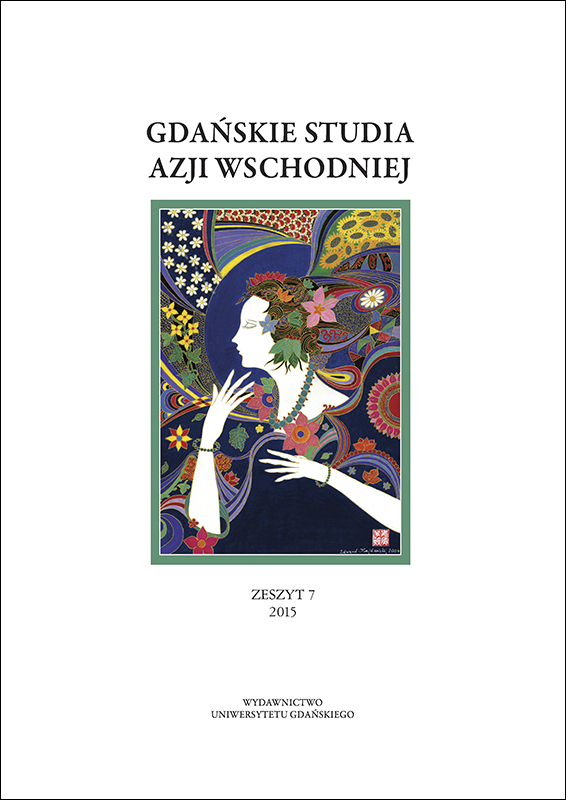
Speaking of Japanese culture, always brings strong associations with bushido codex of samurai, sushi cuisine, blossoming trees of cherry trees and historic clothing like kimonos. Many more can be mentioned, although there is one, the most visible aspect of their life – the presence of manga. Manga (jap. 漫画) nowadays well known around the globe is not so young as many of us believe. The history of the most famous comic books in the world started almost hundred years ago with first Japanese traditional images known as emaki (jap. 絵巻) literally translated as picture scrolls. After many centuries, the period of Edo (1603–1868) revealed new type of art: ukiyo-e (jap. 浮世絵). New technique of woodcut inspired many of artists. One of them, Katsushika Hokusai created The Great Wave off Kanagawa, famous of being the most popular Japanese art of all time. He, also as first man in the world, introduced the term Manga, which means flowing words. During years of historic changes, new kind of infl uence approached. Western foreigners started to discover sacred land of Japan, inspiring them to change old-fashioned lifestyle. European artists set new standards in art, causing caricatures cartoons to appear in local press, inspiring young generations of drawers. Post-war Japanese artist – Tezuka Osamu brought revolution to comic world, with first manga comics such as: Astro Boy (1952), Kimba the White Lion (1950) and Pheonix (1967). Many artists, inspired by Osamu’s work, started creating their own manga. Walt Disney’s technology of animations enabled to bring characters from Japanese comic books to move on screen. During 80’s first anime, as Japanese animations were called, were broadcasted. Dragon Ball, Sailor Moon and Pokemon are only few titles that introduced world of manga and anime to the wider audience. Nowadays, young people each year create new artworks inspired by Japanese style of drawing. Nonetheless, manga and its long history, in large extent, popularized Japan among other countries.
More...
Set amid stunning mountain scenery, ‘The Eagle Huntress’ follows a teenager’s dream of becoming a master of her craft.
More...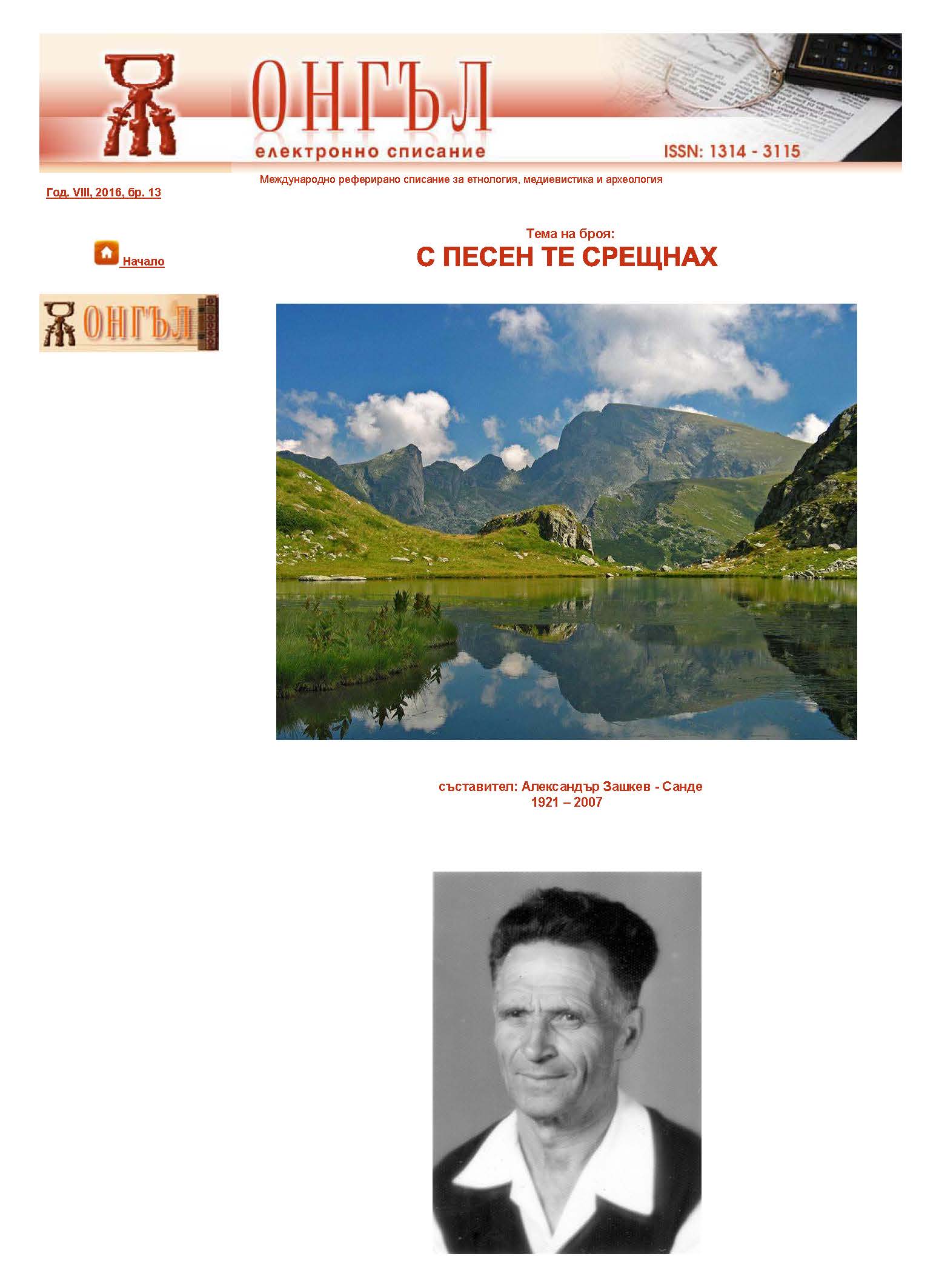

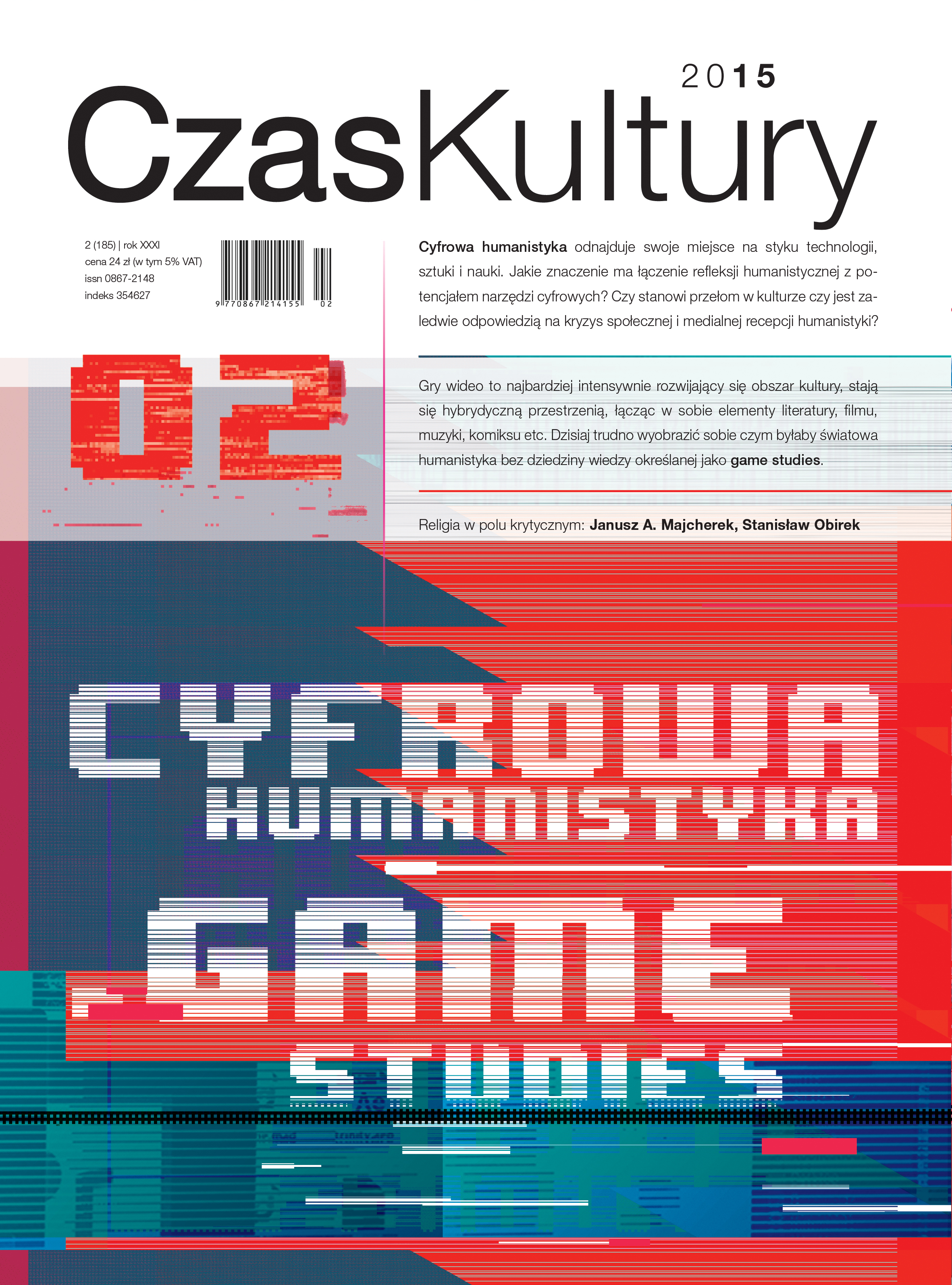
Polish cities are currently undergoing a process of being “reclaimed” by their inhabitants. This urban revival seems not so much a form of recompensation for years of PRL rule over Poland’s cities, but rather a response to the effects of the political transformation on the city: the impact of the liberal economy on the elimination of spatial planning, the commercialization of urban space, and the growing belief in the sanctity of private property. In the midst of initiatives, discussions and publications that have stimulated the return of a humanitarian ethos to Polish cities and calls for them to be perceived as compact spaces that require plans for sustainable development, and the ability to read and skilfully guide the complicated grammar of city streets, squares and buildings, a Polish translation appeared of the book "The Death and Life of Great American Cities" by Jane Jacobs (1961). Although written more than half a century ago and focusing on New York, it anticipates today’s thinking about cities, distancing itself from traditionally understood urbanism (as the study of a grid of streets and squares), and proposes a holistic vision of them as a dynamic structure resulting from various “civilisational” processes, including some of an economic nature.
More...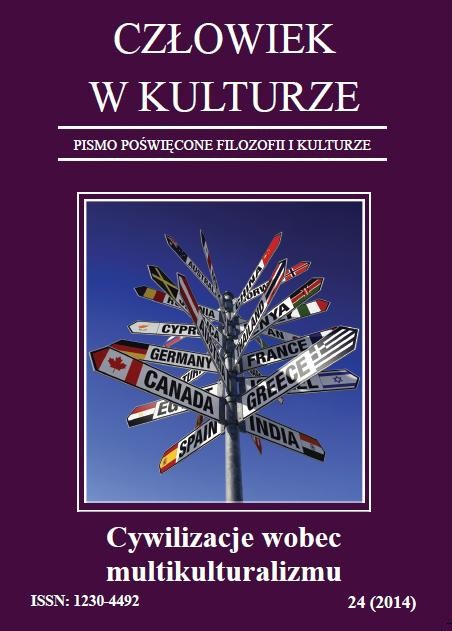
In this article the author tries to analyze extraordinary life of famous painter Vincent van Gogh. The article consists of eight parts. The author stars with the general characteristic of Vincent’s childhood, which was the product of a strict Calvinist upbringing, and his first apprenticeship with the international art dealers, Goupil. The second part concentrates on Vincent’s attempts to follow in his father’s footsteps, his preoccupation with religion and study of the Bible, which led him to missionary work as a lay-preacher in the Borinage, a coal-mining district in Belgium. In the third part the author tries to show the beginnings of van Gogh’s art work, but the author notes that Vincent wasn’t really interested in following any traditional art education. In another part of the article the author concentrates on stormy relationship with Clasina Maria Hoornik, better known as Sien, a woman older than Vincent. In the fifth part author notes that Vincent finally understood that to be taken seriously as an artist, he had to come to Paris, where he befriended many of the aspiring artists of the day. The six part concentrates on van Gogh’s staying on the south to Arles, in Provence and his unsuccessful attempt to realize the biggest dream of his life, establish an artists’ colony, a “Studio in the South”, as he called it, where artists could work together in a collegiate culture. In another part of the article the author focuses on tragic consequences of Paul Gauguin’s stays in Arles – Vincent suffered repeated episodes of mental instability and madness. At the end of the article the author concentrates on van Gogh’s stays in Auvers and the mystery of his tragic death.
More...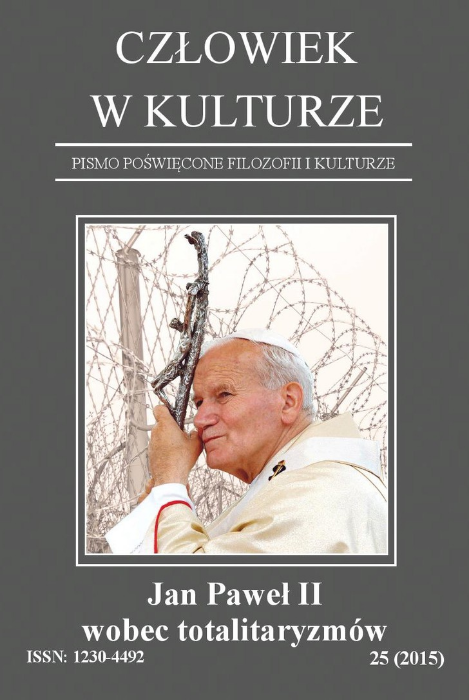
In the introduction to the article, the author cites and analyses the key assumptions of personalistic anthropology made by Karol Wojtyła/John Paul II. Based on the aforementioned philosophical analysis, the author of the article notices that in the centre of both content and message of the poetry by Karol Wojtyła/John Paul II there is a human being whose personal features may be perceived through the prism of poetic considerations given to work, fatherland and social life, over faith and prayer. It is a poetry bearing the stamp of two totalitarian systems as well as the aversion of the author to avant-garde which ‘has forgotten about a human being’. The exemplary anthropological threads specified above are intertwined and become prominent when one assumes the perspective of reference to God and to the miracle, which consists in discovering His Existence and the miracle of trying to penetrate His Mystery.
More...
In her article, the author refers to the views on art, held by St John Paul II. As the author of the article notices, St John Paul II, in his Letter to Artists compared the human creativity to God’s creativity and referred to him as the ‘divine artist’. The author of the article wonders whether the ‘anti-art’ may similarly be called as imitating the Angel of Darkness. This text constitutes an attempt to show the manner, in which the divine artist and the fallen Anti-artist act and how a man, as a rational and free being, recognising the reality, as if imitates both God and Satan, both of whom are more intelligent than a human being. This text attempts to answer the following questions: is this imitation somehow conditioned and is there a way to avoid it? Can any already chosen artistic path be changed? Do the man and the world assume responsibility for activities? Justifying the answers, the author refers to the classical, Greek conception of art, which explains both the essence and the ultimate reasons for the existence of art.
More...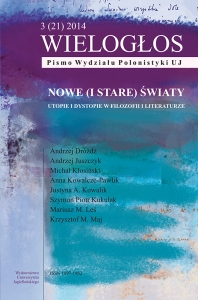
The article focuses on the origins of Eutopian and Dystopian aspects of selected works of Stanislaw Lem, which were divided into pre- and post-Thaw ones (due to the differences in their relation with the tradition of that genre). Eutopian characteristics can be found in the first science fiction stories of Lem (both quasi-social realistic ones, set in the Communist Bloc countries, and their darker counterparts, set on the other side of the Iron Curtain). Technology seems to be more important there than politics. Similarily, science and technology form the basis of Eutopian visions of communist paradise in The Astronauts and The Magellanic Cloud (as well as Dystopian images of the enemies of communism in both novels, Venusians and long-dead “Atlanteans”, i.e. NATO members). Their very creation seems to be an effect of Lem’s own desire to write about space travels, which – in Stalinist era – wasn’t possible any other way. After the Thaw, both Dystopian and Utopian elements in Lem’s fiction gradually lose their political characteristics, corresponing with the grow of Lem’s interest in more universal matters. His later utopias still seem to origin primarely from the field of science and technology, and not of politics or philosophy. Their tone reflects the author’s loss of faith in the possibility of creating the paradise (on Earth, or interplenatary one) through either political or technological means. This can be observed as well in what could be called ‘broken utopias’, like the world of short stories about Pirx the Pilot.
More...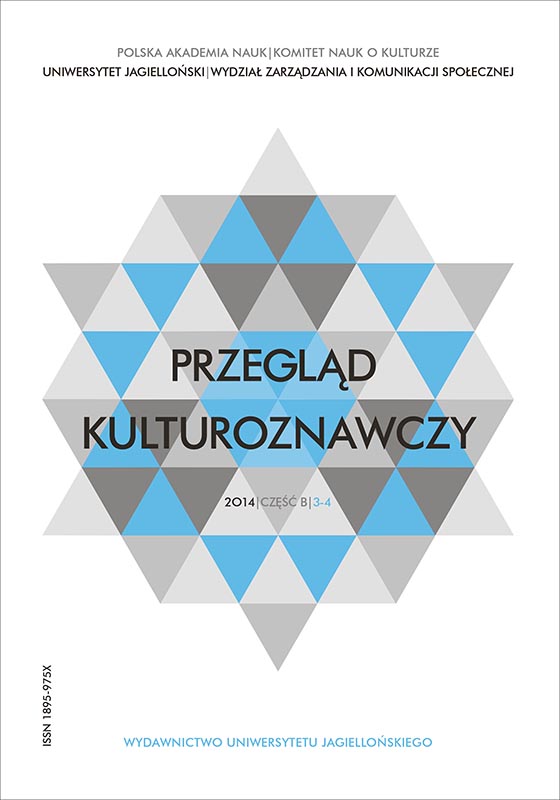
Rozważania podjęte przez autorki tekstów zamieszczonych w niniejszym numerze „Przeglądu Kulturoznawczego” dotyczą różnorodnych zagadnień związanych z obecnością kobiet w kulturze wizualnej Galicji – fotograficznej i filmowej – zarówno jako jej kreatorek, jak i odbiorczyń. Wybór obszaru dawnego zaboru austriackiego podyktowany jest chęcią podjęcia lokalnych badań, ograniczonych do historycznego (i mitycznego) terenu o wyrazistej, choć niejednorodnej, tożsamości kulturowej wynikającej z politycznych, ekonomicznych, społecznych, ale i kulturowych uwarunkowań.
More...